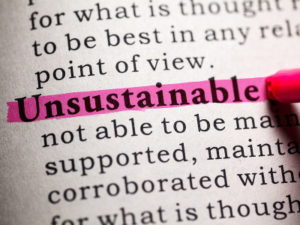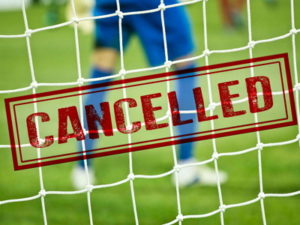Are Professional Sports Becoming Financially Unsustainable?
 If you were to take a look back at the FIFA World Cup 2018, it would be quite likely that you would see the appeal that sports and sports betting has. Online sportsbooks witnessed immense numbers of people placing wagers on their favoured teams to win, and at that point, you could have looked ahead and thought that professional sports had such a solid position in the world. That momentum carried on into 2019, but nobody could have predicted what 2020 would bring.
If you were to take a look back at the FIFA World Cup 2018, it would be quite likely that you would see the appeal that sports and sports betting has. Online sportsbooks witnessed immense numbers of people placing wagers on their favoured teams to win, and at that point, you could have looked ahead and thought that professional sports had such a solid position in the world. That momentum carried on into 2019, but nobody could have predicted what 2020 would bring.
As the influx of COVID-19 was felt around the world in all countries, it also exposed the precarious balance that sports, and subsequently sports betting, has. The pandemic has gone on for much longer than many people originally anticipated, and sports events have been put on hold, postponed and altogether cancelled. The 2020 Tokyo Olympics was one of the largest to be affected, with everything being postponed until 2021. And if the Games cannot take place in 2021, they will be scrapped, says chief Yoshiro Mori.
Due to the ongoing threat of coronavirus, many sports teams and governing bodies have been placed right on the edge, due to the lack of events taking place, absence of spectators from those that are allowed to continue now, and so on. And that’s just from the past six months or so many would argue that some professional sports have simply become to big and corporate to maintain and even small shocks are now threatening their existence such is their reliance on revenue to maintain these levels.
Are professional sports something that can be considered sustainable for the future? Or have they grown so large and commercial that they have become unsustainable as a consequence? Have they lost their true values in the end? We’ll be taking a look at these questions and figuring out what the answer is. Plus, if the bubble is about to burst, what options can sports teams and governing bodies do to help? With bans potentially coming into effect on sports betting advertisements, what effect will this have on the gambling industry given betting companies are a massive source of revenue?
Most Unsustainable Sports in the World
 It is hard to find a sport that has not become corporate and inflated in the modern world. Football is a great example of a game that has gone from a working class sport with little revenue to a multi-billion pound industry. The issue is are these sports and teams becoming too big to fail? Have they become so reliant on the massive revenues that they receive that without them they could not exist? Even lower levels of sport are becoming so corporate that the costs to maintain the structure is starting to cause cracks. The Championship, for example, is the 5th richest football league in the world, making it bigger than most countries first divisions.
It is hard to find a sport that has not become corporate and inflated in the modern world. Football is a great example of a game that has gone from a working class sport with little revenue to a multi-billion pound industry. The issue is are these sports and teams becoming too big to fail? Have they become so reliant on the massive revenues that they receive that without them they could not exist? Even lower levels of sport are becoming so corporate that the costs to maintain the structure is starting to cause cracks. The Championship, for example, is the 5th richest football league in the world, making it bigger than most countries first divisions.
The fact every sport is now broadcast and invested in means there is more competition for a fixed-pool of viewers, naturally this means some sports do well and others fail to attract enough revenue in what is a cut-throat industry. Not every sport and league can be worth billions of pounds with round the clock broadcasts and it seems some genuine sports are losing out in the race for the money they need to survive. This is then exasperated by the simplest knock and something like the corona virus outbreak and the resulting effects have highlighted this precarious balance.
It is not just reliance on revenue that present challenges for corporate sports in the future, other factors such as climate change will come into play. Golf, for instance, isn’t really a sustainable sport. Most 18-hole golf courses are situated on around 110 to 190 acres of land. One acre is approximately 4,067 square metres so let’s assume that there’s an average area of 150 acres per golf course. In 2015, there were a total of 34,011 golf courses around the world in operation, with an average of 17 holes at them. That’s the equivalent of 20,000 square metres. The maintenance of these golf courses means that a hefty amount of water is necessary, especially in places where it is hot and dry.
Sprinklers will be running at full speed in these circumstances. One golf course can essentially utilise as much water as seven million households, and when you combine this with the massive deforestation required to construct courses in the first place, golf just isn’t helpful.
Winter sports tend to be high on the list of the sports that are most affected by climate change, as due to greenhouse gases, the snow season could be shortened by up to 80% by 2090. Unfortunately, some of the ski slopes are partly to blame for this, as they also engage in deforestation to create their landscapes. It also costs a lot of water for snow cannons, as well as energy to maintain the slopes themselves.
Of course, this has nothing to do with the COVID-19 pandemic, but more so to do with the affects these sports have on climate change. That does ensure that in the very long-run, they are unsustainable. But how has this been exploited by the worldwide issues relating to coronavirus?
Coronavirus Highlights Unstable Situation
 In March of this year, a report was published that displayed the staff costs at the top English football clubs. These figures also displayed the outright decision that those costs, and consequently, the clubs themselves, are unsustainable. The pandemic led to the suspension of all football in England until April 30 at the earliest. And while plenty of focus was placed on the clubs in the lower divisions of the English Football League (EFL) coming under financial pressure, those in the top two leagues were also predicted to feel the strain of such in the proceeding months.
In March of this year, a report was published that displayed the staff costs at the top English football clubs. These figures also displayed the outright decision that those costs, and consequently, the clubs themselves, are unsustainable. The pandemic led to the suspension of all football in England until April 30 at the earliest. And while plenty of focus was placed on the clubs in the lower divisions of the English Football League (EFL) coming under financial pressure, those in the top two leagues were also predicted to feel the strain of such in the proceeding months.
At the same time, reports suggested that part of the emergency £50 million funding package that was released by the EFL was an interest-free loan to each Championship club of £584,000. Vysyble, the group of financial analysts, said that the amount added together across the 24 clubs in that division, equating to £14.02 million, would not even cover a week’s worth of total staff costs. A figure was given of £16.32 million for these costs instead.
The picture remained just as bleak for the Premier League clubs, where it was calculated that total staff costs for a single week amongst the 20 teams was around £68.46 million.
At the same time, those topflight clubs were reportedly going to lose around £750 million in broadcasting revenue, due to the cancellation of events. Therefore, instead of cancelling them, it was decided that those 2019-20 season events would continue at a later time in the year – something that has now been taking place minus the crowds.
According to Vysyble analysts, data indicated that “the 2018-19 season accounts would produce record losses for the Premier League clubs and a continuation of heavy losses for those in the Championship”.
In total, 15 of the 26 Premier League and Championship clubs that have released their full 2018-19 accounts have staff cost to revenue ratios that are in excess of UEFA’s safe limit of 70%. Therefore, the hit from COVID-19 and the restrictions it imposed on top of last season’s poor financial performance were expected to combine and enforce quite the knock on football.
Worldwide Sporting Figures
 The global value of the sports industry was estimated to be $471 billion (£364 billion) in 2018, and that is a huge increase of 45% since 2011. Prior to the effects of coronavirus, the only way things seemed to be going for sports was upwards. Now though, every part of the sporting value chain has been affected. This includes not only the athletes themselves, but the whole teams, the leagues associated with such and onwards to the media that broadcast games, and on the wider scale of things, the sportsbooks that provide betting on them.
The global value of the sports industry was estimated to be $471 billion (£364 billion) in 2018, and that is a huge increase of 45% since 2011. Prior to the effects of coronavirus, the only way things seemed to be going for sports was upwards. Now though, every part of the sporting value chain has been affected. This includes not only the athletes themselves, but the whole teams, the leagues associated with such and onwards to the media that broadcast games, and on the wider scale of things, the sportsbooks that provide betting on them.
Sports leagues generally have three main streams of income supporting their continued play – broadcasting (sales of media rights), commercial (advertising and sponsorship partnerships) and match day revenue (ticket and hospitality purchases). Of course, professional sports leagues are quite analogue when it comes to entertainment companies. Each team in a league is pretty much like a different channel. The teams all come with their own identities, employees, fan bases etc. but the general rules of the games and the fixture lists are set by the leagues themselves. The more people there are viewing the product, the more valuable it becomes.
Major sports are primarily reliant on broadcasting income. In the years from 2014 up to 2019, revenue from the biggest leagues has come mostly from this area, with the global value of sports media rights being around $50 billion (£38.6 billion). However, 60% of that is accounted for by just 10 worldwide sports leagues!
The National Football League (NFL) has the highest revenue of all major sports leagues, equating to over $12 million (£9.2 million) on average over that aforementioned five-year period. Of that figure, just under $10 million (£7.7 million) of it comes from media rights. Major League Baseball (MLB) is next in line, while the National Basketball Association (NBA) follows on from it. England’s Premier League is also up there, averaging just over £4.6 million in revenue over that five-year period. Just under £3.1 million of this comes from broadcasting media rights.
Moving on to 2019, the NFL remains in prime position for broadcasting media rights, with others in the top leagues including the English Premier League, La Liga, Bundesliga and NHL.
However, despite the fact that these leagues are likely to remain in their top positions for the 2020 period as well, the likelihood is that their revenue figures will have substantially dropped by the time their respective reports come in. Even prior to COVID-19 though, some people questioned the sustainability of the deals signed into with broadcasting companies. When the acceleration in “cord-cutting” (people choosing online entertainment from Netflix and so on rather than traditional TV/cable companies) is taken into consideration, it’s a genuine concern to hold. Especially now.
Shutdown of Sporting Events Affects Other Sectors
 It was noted at the beginning of many countries’ lockdowns, that anything longer than a temporary shutdown would see leagues be unable to meet their commitments to broadcasters. That, in turn, would also limit their ability to distribute income back to the sports clubs as a result.
It was noted at the beginning of many countries’ lockdowns, that anything longer than a temporary shutdown would see leagues be unable to meet their commitments to broadcasters. That, in turn, would also limit their ability to distribute income back to the sports clubs as a result.
No sports events taking place means no television deals to sign into and no matchday income, either. No income means that there would be no funding for the clubs to continue operating in the future. And that’s something that would definitely affect the lower divisions initially but expand to have a major impact on the larger sporting leagues in due course, too.
Of course, with a lack of sporting events, there would be very little for online sportsbooks to provide odds on for their members to wager on. Today’s sports betting world is exceptionally competitive, as there are masses of sports for you to wager on in comparison to the number of such available say 20 or 30 years ago. Options like eSports have only recently become available and gained in popularity at online sites with bettors. However, with events like these even being postponed and cancelled during the pandemic, there was little for gamblers to wager on in this area.
Strategies To Reduce Disruption?
 The sports industry is trying to capitalise on the spike in media consumption by coming up with new ways to engage their consumers. With live games not completely back in action yet, the first course of action has been to deepen the pool of content that is available to fans. In this respect, sports broadcasters like ESPN and Fox Sports decided to show classic games, archived content, documentaries and so on in relation to different sports. This is the same route that Sky Sports and others in the UK took with football and so on.
The sports industry is trying to capitalise on the spike in media consumption by coming up with new ways to engage their consumers. With live games not completely back in action yet, the first course of action has been to deepen the pool of content that is available to fans. In this respect, sports broadcasters like ESPN and Fox Sports decided to show classic games, archived content, documentaries and so on in relation to different sports. This is the same route that Sky Sports and others in the UK took with football and so on.
These routes were taken in a bid to keep consumers interested in watching different sports. Individual leagues opted to do the exact same thing, too. The NFL also made every game since 2009 available to stream via its own direct-to-consumer channel entitled Game Pass. That led to a 500-fold increase in daily sign-ups for the service.
Leagues like the NBA and the English Premier League turned to cyber events, hosting NBA 2K and FIFA tournaments via the PlayStation 4 and/or X-Box. This not only allowed various players to play their respective sports from home (albeit via computer) against others, and in the meantime, sports bettors had the opportunity to place wagers on those tournaments, too.
Another approach that was undertaken during this time was to increase the flexibility of how consumers could pay for sports content. Some leagues opted to put their archives of previous games on YouTube for fans to watch for free, as a way of keeping them interested during the shutdown period. Discussions also took place between sports bodies and TV network partners as a way of finding mutual solutions to “force majeure” clauses that operate positively for both sides. Those solutions included broadcasters being compensated by the leagues, which would grant additional rights and extend arrangements as well.
Of course, because there is no real timeframe in place as to how long the COVID-19 pandemic is likely to continue, it’s something that will need to be frequently reviewed, without a doubt. Yet, larger sports teams are becoming so big and dependent on broadcasting funding and so on that it’s not likely they can be sustained at such a level for long-term. And the pandemic has outrightly proved that in more than one way.



